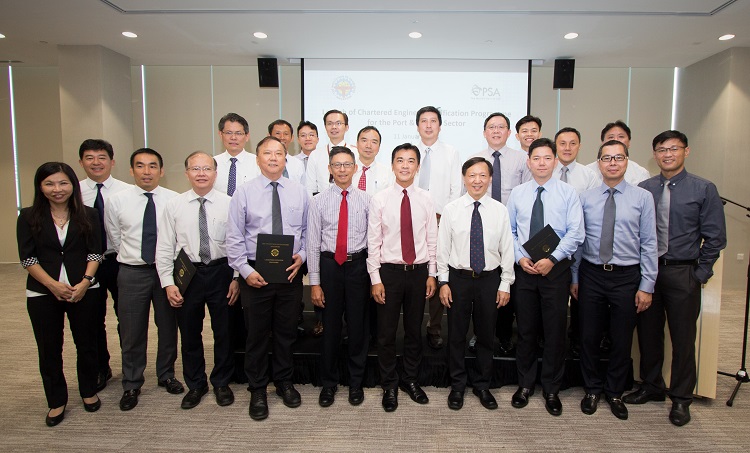PSA Singapore Showcases Future Port Technologies
Port operator PSA Singapore is holding an exhibition this week to showcase its advanced port technologies including drones, automated quay cranes, exoskeletons for port staff and robotic arms.
The Intelligent Port of the Future exhibition at Pasir Panjang Terminal Building 3 opened on Wednesday and will run until Sunday. Divided into three zones, the exhibition begins with a look back at PSA’s early years in adopting technology, and takes visitors through its present-day innovation drive to show the progress being made in the use of automation, data analytics, robotics and other technologies to be implemented in our future port facilities.
Robotic Arm for twist lock handling
Currently, lashing specialists fix and remove twist locks during the container loading and discharging processes alongside the quay cranes. Advancements in technology will streamline this process, where automatic platforms or robotic arms could be used instead. PSA says it is looking to upskill workers performing such tasks, so that they can work aided by mechanization and therefore assume other higher value-add responsibilities. There is potential for a single trained operator to support multiple robotic arms in case of exception or error handling.
Drones
PSA is considering new types of drones that fly autonomously through software controlled flight plans through their integration with Internet of Things (IoT) technology. Drones can be used to fulfill ship-shore or shore-ship deliveries. Working with on-ground IoT sensor networks, drone surveillance can also help with terminal security, providing an easier, faster and cheaper method of data collection.
Inspections are also a major application for drones, says PSA. These can range from a basic port equipment structural inspection requiring images of a crane structural joint, to the complex inspection of an energy installation in the port infrastructure. PSA is also looking towards the development of amphibious drones that can operate over and land on water to inspect wharf side fenders.
Future Command Center
A mock-up of how a future command center may look in the future is being showcased at the exhibition. The one-stop command platform could be used for the co-ordination of automated port equipment, including automated rail-mounted gantry cranes (ARMGs), automated guided vehicles (AGVs) and automated quay cranes (AQCs).
Exo-skeleton
Powered exo-skeletons are wearable mobile machines driven by a system of motors and linkages allowing for limb movement with increased strength and endurance, allowing port workers to perform strenuous and physically-demanding motions without fatigue.
Data Analytics and Simulation
PSA plans to leverage data analytics in the future port in areas such as equipment specialist performance, crane maintenance and simulation models which allow PSA to simulate container port operations.
To enhance equipment specialists’ performance, data analytics would work in tandem with machine learning to analyze work performance. This could be used to pinpoint specific areas of improvements for individual specialists with greater accuracy, via the recording of information through sensors mounted on port equipment.
Crane maintenance is another example of the application of data analytics. Quay cranes used to load and unload ships undergo regular preventive maintenance to ensure they operate smoothly. Data analytics enables a more effective and just-in-time approach through predictive maintenance. Sensors on each crane provide vast data streams which are analyzed, and along with machine learning algorithms, can better predict failure times for each crane. This results in more lead time to arrange for replacement parts, roster the service crew and identify operational lulls, optimizing the use of cranes in the intervals between maintenance.
Simulation too will play a key part in the port of the future, says PSA, with computer software used to imitate the behaviors and interaction of real-world actors – equipment, people and systems – in a virtual environment. Planners can predict outcomes before implementation. Beyond this, container terminal emulation models will allow PSA to predict, evaluate and refine in high fidelity the behaviors of future fully-automated terminals.
Smart Glasses
Using Augmented Reality (AR), smart glasses will provide port equipment specialists with live visual aids and off-site assistance. AR technology facilitates the visualization of an equipment’s components and the tracing of its defects. These will ease the troubleshooting process and reduce the downtime of faulty equipment. The ability to see visual indications and communicate with subject matter experts in a mixed reality space will also allow proper guidance and create an effective learning experience at every repair.
Engineering Certification
The exhibition is also playing host to other events, including the launch of a chartered engineer certification program for the port and marine sector by PSA and The Institution of Engineers, Singapore (IES).
Launched by IES in 2013, the Chartered Engineer certification program is an external validation of an engineer’s experience, expertise and technical competence across various sectors. This collaboration allows port engineers with the requisite experience and training to be conferred a globally recognized certification of engineering professionalism.
Regional CEO Southeast Asia, PSA International, Ong Kim Pong and Deputy President, IES, Dr Yeoh Lean Weng presented the certificates for the program to the pioneer batch of 13 engineers from the Maritime and Port Authority of Singapore, PSA, Jurong Port, Portek International and National University of Singapore. The engineers passed a rigorous assessment process that looked at their experience and skills in managing complex engineering systems and commitment to developing the skills of others in the engineering profession.

that matters most
Get the latest maritime news delivered to your inbox daily.
In tandem with the certification, PSA will collaborate with IES to identify relevant skills development programs for the engineers to enhance their engineering capabilities to meet the needs of the intelligent port of the future.

